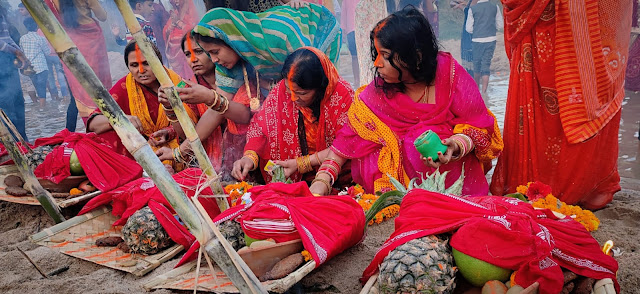Chhath Puja - History, Importantance and Significance
 |
| Devotees with Chhath Puja Material |
The Chhath Puja is a Hindu Vedic festival celebrated particularly in the states of Bihar, Jharkhand, Uttar Pradesh, parts of Madhya Pradesh, and parts of Nepal.
It is dedicated to the Sun God [Bhagwan Surya] and 'Chhathi Maiya'[छठी मैया] and is celebrated twice a year - two months in India - Chaitra (March-April) and Kartika (October-November).
The last one is believed to occur after Diwali and is very famous. “It falls in the Suklapaskh month of Kartika Maasa", Shukla Paksha is a 15-day waxing moon cycle that begins with the new moon (अमावस्या) and ends with the full moon (पूर्णिमा).
The festival, where women sing and celebrate on the day of the festival, is full of joy and color of life, environment, clothes, and food. Women believe in this strict fast in which all wishes are fulfilled, accompanied by beautiful ceremonies and handmade details.
Across many years, Chhath Puja has kept its cultural importance and people still celebrate it with lots of excitement. The rituals, songs, and customs have been passed down from one generation to another.
Beliefs behind why Chhath is celebrated :
The roots of Chhath Puja is not specific. It is believed to have originated from the Vedas, Epic Mahabharata, and Ramayana.
In the Ramayana:
According to the Ramayana, it is believed that Lord Ram and Mata Sita fasted and performed puja to Bhagwan Surya during Shukla Paksha of Kartika Maasa after completing their 14-year 'exile'[वनवास], Since then Chhath Puja became an important and traditional festival in the Hindu religion.
In the Mahabharat:
Draupadi and the Pandavas were exiled and sought help from Dhaumya. Dhaumya advised them to fast and pray to the sun. So, they celebrated Chhath Puja to solve their problems and restore their lost kingdom. Finally, all their prayers were answered. Therefore, it is believed that by worshiping Bhagwan Surya during Chhath Puja, one could fulfill all needs and get rid of all pain and suffering.
Also, in the Mahabharata, Karna, the son of Mata Kunti and Bhagwan Surya, worshipped his father's sun every day and performed special puja during Shukla Paksha, the month of Kartik. Karan was also the king of Aang, now known as Bhagalpur in Bihar.
In the Vedas:
It is believed to have originated from the ancient Vedas, particularly the Rigveda, which contains hymns dedicated to the worship of Bhagwan Surya. These hymns describe religious rituals and show clothing similar to those worn during worship. The Vedas speak of the worship of the Sun God and encourage Simple and moderate rituals.
The history of yoga or the science of Chhath Puja dates back to the Vedic period. In the past, The rishis and saints used this method to survive without eating other food and could obtain energy from sunlight. This was achieved through the practice of Chhath Puja.
The Story of King Priyabrat:
Once upon a time, there was a happy king named Priyabrat and his wife, Malini. Despite their contentment, the couple faced the sorrow of not having a child. Determined to change their fate, they sought the guidance of Maharishi Kashyap and decided to perform a Maha Yagya.
King’s wife Malini got pregnant and delivered a dead child. With this, the king loses hope of decided to give his life. Suddenly, Devsena, also known as Manas Kanya, appeared. She said, 'I am Goddess Shashti, representing a part of the universe. If you worship me sincerely for six days, you will be blessed with a child.' The King and Queen agreed, worshipped, and were blessed with a beautiful baby boy.
A Grateful Celebration of Harvest:
Chhath Puja is also associated with the harvest season and symbolizes gratitude for the harvest. These rituals include offering the first crops of the season to the sun god as an expression of gratitude.
How Chhath Puja is Celebrated:
Chhath Puja begins on the sixth day of the month of Kartik, usually in October-November. Some people also celebrate the month of Chaitra (April) called Chaiti Chhath.
'Chhathi Maiya'[छठी मैया], the sister of the god sun, is considered a strict but generous deity. Although the rules of the four-day festival are very strict, it is said that those who complete them will receive great spiritual benefits.
On the first day of the puja, known as 'Nahaye Khhaye' [
नहाय खाय
], devotees consume food (खाना) after taking a ceremonial bath(नहाना) in a river, pond, or sea. The food for fasting individuals is prepared on the 'chulha' [चूल्हा], using water collected from the water source during the festival. A pumpkin sabzi is a meal consumed following the bath.The second day is called 'kharna'[खरना], on which the one observing the fast takes only one meal in the evening, of 'roti' and 'kheer'[खीर]. This is also the day friends and family gather to prepare 'Thekua'[ठेकुआ], which is fried in ghee. It is prepared by taking great precautions to make sure they are perfect for the deity. People can have them only after they have been offered to God.
After the roti-kheer meal begins a 36-hour fast, during which devotees don’t even drink water.
 |
| Kharna Prasad (roti-kheer) |
On the third day, devotees go to the banks of a water body. Those who can’t, build a temporary pool in their homes. The banks are decorated with diyas, rangoli, and sugarcane. Offerings to the Gods, such as seasonal fruits like sweet potatoes, water chestnuts, pomelo, bananas, and more are arranged on a special plate[सूप], made up of Bamboo.
As the Sun sets, the person who's been fasting holds up the special plate[सूप], as a humble offering called 'arghya'[अर्घ्य]. Friends and family join in, pouring either milk or water onto the special plate[सूप]. This beautiful ritual is known as the "Sanjh ka Arghya"[संध्या अर्घ्य].
The fast finishes on the fourth day of Chhath, when 'Usha Arghya'[भोर का अर्घ्य] is offered to Surya Bhagwan and 'Chhathi Maiya'[छठी मैया]. Then prasad from the special plate[सूप] is first eaten by the devotees after it is shared with all the family members of the devotees. Afterward, everyone heads back home from the riverbanks, feeling thankful for successfully completing the challenging festival and being part of it.
There are many reasons why Chhath holds a special place in the heart of Bihari. The festival symbolizes the unity of the society and the return of Bihari immigrants to re-understand themselves in their culture and country.
People from any caste can celebrate this festival. There is no priest involved, so they can directly fast and pray for the vision so that God Sun, who shines equally on everyone, becomes visible. The offerings to the God Sun consist of local seasonal fruits and are therefore easily available. Fasting is observed by both women and men and is dedicated to God Sun, not to the husband or children.
No matter how rich or poor you are, the rules are the same for everyone, and the success of the festival lies in how faithfully you observe the rules, not in what scale you observe them.





Great Article. 🙏
ReplyDeleteI did not knew the reason behind the celebration chhath pooja, before reading this article.
Chhath is not just a festival, it's an emotion for millions of Bihari❣️❣️
ReplyDeleteExcellent blog, Looks like it is written by professional.
ReplyDeleteGood Job.
Your blogs are always so well-researched and decorated.
ReplyDeleteKeep it up.👍🤩
I have read many aritcle about chhath puja on internet, but this article is really amazing.
ReplyDelete